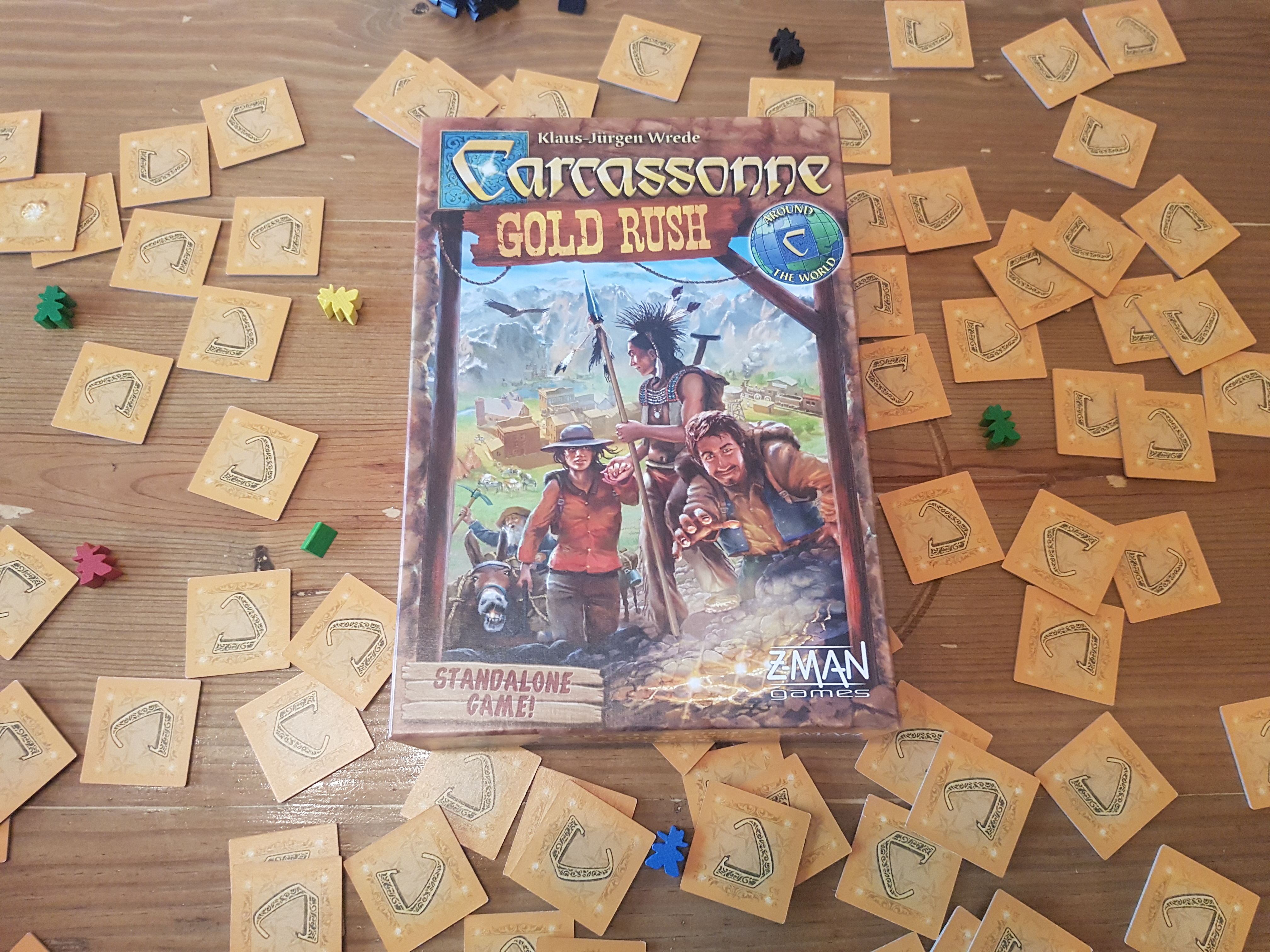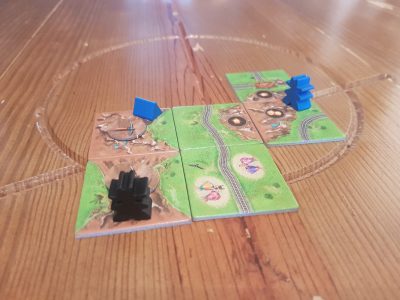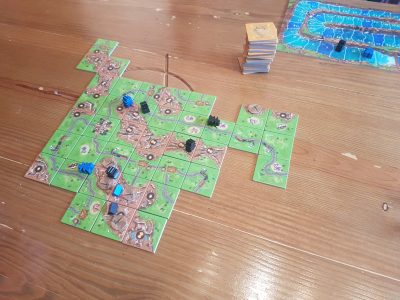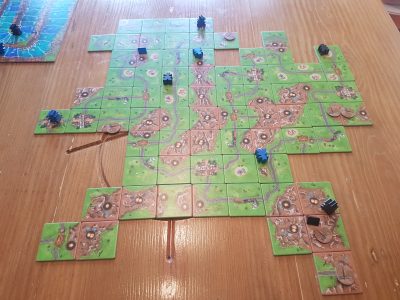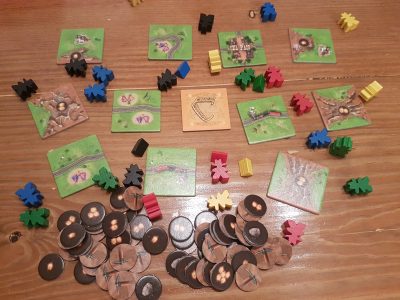Carcassonne Gold Rush is the second title in the “Carcassonne: Around the World” series of games, which sees the base game of Carcassonne slightly adapted and taken to a new location. In this version players will take up the roles of cowboys in 19th century North America in the midst of the gold rush. Players will fight for control of gold mines; railway routes will spread across the map and Native American camps also come into play. Yet, how well has the family friendly game of Carcassonne been adapted for this new theming? Let’s find out!
Carcassonne Gold Rush is, like the rest of the franchise, a tile layering game where players look to expand the map in front of them tile by tile, scoring points along the way. In this version the tiles main features are made up of Mountains, Railroad Tracks, Cities and Prairies. On a turn the active player will take a tile from the draw pile and fit it into the central board somewhere, carrying on the illustration of the already placed tiles.
If the tile you have played has a feature on it, for example a railroad, which is unclaimed you can place a meeple (cowboy) to claim it. Following the example when that railroad is complete (has a defined start and end) the feature is scored and the meeple is returned to the player. Each feature scores slightly differently. Different in terms of the amount scored in this game and different from similar features in the original Carcassonne.
Like with roads in the standard Carcassonne, railroads score 1 point per tile when they are completed. Taking some inspirational cues from the Carcassonne expansion Inns and Cathedrals there is an opportunity to gain double points. A small number of the railroad tiles feature a train on the tracks. Including one of these tiles into your railroad will result in the points per tile raising to two. However, to counter this if a second train tile (or more) is placed on the same railroad the points are returned back to 1 point per tile.
Mountains replace the sprawling cities of the base game and bring in a different way of scoring. Instead of a consistent 2 points per city tile when completed the number of golden nuggets featured on the mountain are the number of points earnt, ranging from 1-3. On top of this, literally when it comes to the tile, are gold nugget tokens. When a mountain tile is put into play gold nugget tokens are placed on it equal to the number of nuggets shown on the tile. These offer bonus points at the end of the game if collected and range from 0 – 5 points.
There are two ways of obtaining these tokens. The first is to simply complete the mountain and then the player in control gets the tokens. The second way is via the special wooden gold miner tent, which each player has one of. On a turn after playing a tile, instead of placing a cowboy a player can move their tent to any unfinished mountain on the board. On a future turn instead of playing a cowboy or moving the tent that player can choose to mine one token from the mountain, potentially stealing bonus victory points from under another player’s pickaxe!
Not to be confused with the cities in base game, Carcassonne Gold Rush Cities are single tiles that work very similar to monasteries. Instead of a 3×3 grid scoring nine points, as monasteries do, 3 points are scored for each completed railroad from the city. Cities have either 3 or 4 railroads from them so can be worth 9 or 12 points in total. Due the high scoring potential it makes it worth getting some tiny railroads completed around the City to grab the points quick, especially as each player only has 4 placeable meeples. There are 5 cowboy meeples of each colour but one is used for the scoreboard.
Prairies are very similar to the fields of the original, being the grassland separated by railroads and mountains. Claiming a prairie can still be very lucrative; it is how points are scored that differs. Most would expect, with mountains being like cities from the original, it would be for each completed mountain on the prairie. Instead, points are awarded for specific pieces of art flair: 4 points for each herd of wild horses and 2 points for each Indian camp. Initially, glancing at the tiles I assumed these were just for theming and flavour. Just like farmers in the original the points prairies can score are insane, so keep an eye out for big point swings!
At the end of the game whomever has the most points wins. More so than in the original, it is a bit of a mystery. This is due to both the gold nugget tokens and the points from prairies being scored after all tiles are played. Some gamers will like this mystery while others will find it drags out the last moments of the game as mental maths is needed.
Every decision to place a cowboy meeple is a bigger investment than ever before in the Carcassonne series, due to the reduced amount available. No longer can you consistently gamble on structures as get blocked off and you’re down to only three meeples. Go for a Prairie early and suddenly you only have 2 meeples to play with, not much for providing competition for railroads or mountains. As a result, often players will choose not to claim a feature, a decision helped by the ability to then obtain a gold nugget token from an opponent’s mountain.
Gold tokens add a rather frustration generating luck factor into the game. It is possible to build a gold mine sprawling across 5-6 tiles and obtain only a couple of bonus points via gold nuggets. In the same game another player could perceivably complete a tiny 2 tile mine and get 10 bonus points. This distorts the balance of the normally solid Carcassonne scoring system.
What doesn’t help the gold nugget tokens is that placing them is fiddly. Only a slight slip and the token flips and everyone gets a glimpse at what it is, not great for the creating a mystery to scoring. There are a bit on the small side, hence the fiddly-ness, though given the size of the Carcassonne Gold Rush tiles (the same size as the original) they couldn’t realistically be any bigger without causing other issues. Slightly annoyingly you cannot just get rid of the gold tokens as doing so would make the tents redundant. These are the most unique elements of this version so it would be a shame to lose both in one fell swoop.
I am a huge fan of the old and new art styles of the base game of Carcassonne so went into Gold Rush apprehensive about change. For me it doesn’t hit the heights of beauty when the map is fully constructed at the end of a game. Nevertheless, it does an excellent job at crafting a gold rush styled map in front of players, even down to the font used for city names. Despite the rule tweaks I’m not a fan of, even the gold nugget tokens, each element builds the game up into a bundle which is thematically tied together. This is a package that sings Gold Rush from the mountains to the wild horses. It really cannot be faulted on theme, it simply shines. This is the saving grace that allows me to look past my issues and dive in, trying to claim gold from others and enjoy the unique Carcassonne experience.
If you are someone whom likes the idea of being able to expand the game in the future then the base Carcassonne is potentially more for you. Whether you are new to the series or are a collector of the Carcassonne Around The World games, Carcassonne Gold Rush will fit nicely into your collection. The slight rule differences to make it worthwhile playing for franchise fans while does little to increase the difficulty for those looking for an entry point. I cannot say the game will hit the table as often as the original, though fans of the gold rush period may find otherwise due to the thematical gameplay. For the sake of being able to change things up from time to time it has just about done enough to earn its place on my gaming shelf.
[Editor’s Note: Carcassonne Gold Rush was provided to us by Esdevium Games for review purposes. The game is currently has an RRP of £32.99. Check out 365 Games for all board games. It is also available from local UK board game stores, find your local store here]

